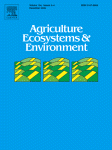Ver ítem
- xmlui.general.dspace_homeCentros Regionales y EEAsCentro Regional Entre RíosEEA ConcordiaArtículos científicosxmlui.ArtifactBrowser.ItemViewer.trail
- Inicio
- Centros Regionales y EEAs
- Centro Regional Entre Ríos
- EEA Concordia
- Artículos científicos
- Ver ítem
Influence of landscape composition on wild bee communities: Effects of functional landscape heterogeneity
Resumen
Landscapes dominated by conventional agriculture reduce and simplify natural habitats, with negative consequences for ecosystem regulating services. We examined differences in structure and composition of bee communities across biotic and abiotic gradients to investigate how these communities respond to land-use changes associated with agriculture. Studies like ours which evaluates the relative effect of different components of spatial heterogeneity
[ver mas...]
Landscapes dominated by conventional agriculture reduce and simplify natural habitats, with negative consequences for ecosystem regulating services. We examined differences in structure and composition of bee communities across biotic and abiotic gradients to investigate how these communities respond to land-use changes associated with agriculture. Studies like ours which evaluates the relative effect of different components of spatial heterogeneity remain uncommon and are important to conserve pollinator fauna. The diversity of floral resources and habitat richness including the configuration and composition of landscape heterogeneity have been shown to influence the diversity of wild bees on a landscape scale. In this study, we examined how wild bee communities respond to landscape heterogeneity in a semi-arid productive region of Entre Ríos Argentina. We modeled the effect of landscape heterogeneity on wild bee community abundance, species richness, and Chao-1 diversity. We sampled bees using pan traps in four common land-uses in the region (forest plantations, pasture/croplands, mixed use areas and native espinal savanna) for five months in the spring-summer of 2014–2015. We identified 96 bee species among 3407 bees collected in the four habitat types. Pasture/croplands along with native espinal savanna supported the highest abundance, richness, and diversity of bees. Species composition of wild bee communities differed between land uses, with numerous species unique to each land use. Across all land use types, diversity of flower resources consistently supported more abundant and diverse wild bee communities. The richness of habitats along with the diversity of floral resources acted synergistically over wild bee communities. Our findings further clarify the relationship between land-use and wild bee communities, which provide valuable pollination services to crops and native plants. Continued expansion of large-scale monoculture forest plantations will likely come at the expense of the native floral resources, which are a key component to support regional bee species richness. Promoting landscapes with a diversity of crops and flower resources are important for the conservation of pollinators that are key for the functioning of ecosystems.
[Cerrar]

Autor
Cavigliasso, Pablo;
Phifer, Colin C.;
Knowlton, Jessie L.;
Licata, Julián Andrés;
Flaspohler, David J.;
Webster, Christopher R.;
Chacoff, Natacha Paola;
Fuente
Agriculture, Ecosystems & Environment 340 : 108150 (December 2022)
Fecha
2022-12
Editorial
Elsevier
ISSN
0167-8809
Documentos Relacionados
Formato
pdf
Tipo de documento
artículo
Proyectos
(ver más)
INTA/PNAPI/AR./Programa Nacional Apicultura
Palabras Claves
Derechos de acceso
Restringido
 Excepto donde se diga explicitamente, este item se publica bajo la siguiente descripción: Creative Commons Attribution-NonCommercial-ShareAlike 2.5 Unported (CC BY-NC-SA 2.5)
Excepto donde se diga explicitamente, este item se publica bajo la siguiente descripción: Creative Commons Attribution-NonCommercial-ShareAlike 2.5 Unported (CC BY-NC-SA 2.5)

